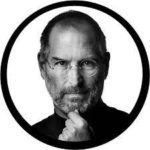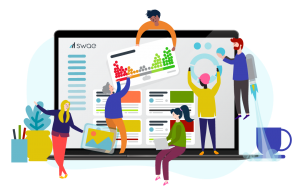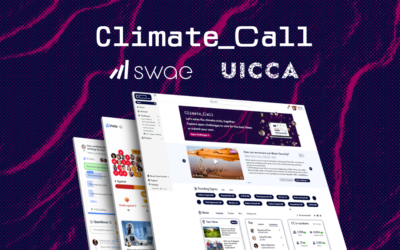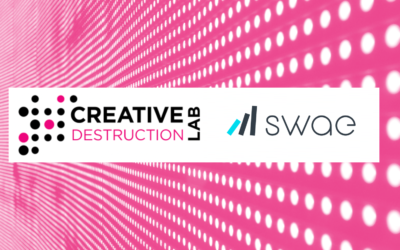High Performers in Companies Around the Globe Use Swae
[Here Are 3 Reasons Why]
1 June 2022 4 min Read
![Young businessman working on his laptop in spacious bright office. Swae_Harvard_Business_review_How to Be Seen as a Brilliant and Bold Leader [Become a Great Communicator].png](https://swae.io/wp-content/uploads/swae-high-performers-use-swae.jpg)
What makes a high-performance leader or employee tick? Research shows that companies win more often when they build genuinely diverse, equitable, and inclusive cultures (learn more here).
These can be high-performing companies or individuals stepping into bold, authentic leadership styles that set them apart from others. Companies and leaders considered to be “high performers” are spread throughout key, identifiable workplaces around the globe and the one thing that binds them together is that to be consistent in high performance they’re setting themselves apart from the status quo and fighting for a new way to do work better.
![Swae-team Swae_Harvard_Business_review_How to Be Seen as a Brilliant and Bold Leader [Become a Great Communicator].png](https://swae.io/wp-content/uploads/Swae-team.png)
Thanks to the Covid pandemic and other social and demographic changes, we’re living through a once-in-a-generation power rebalance between employees and employers. Gone are the days of top-down hierarchical dictatorships in workplaces. We’re seeing a new era emerge with new norms, where people have their voices heard —and feedback turns into new possibilities for organizations to pursue.
High performers win more not because they go against the status quo and this is due to the way that they solve problems. The best way to solve modern-day organizational problems is to have competing ideas on the table to thoroughly discuss, not just the wisdom from a few of those at the top or who are the loudest. New research from Harvard Business Review titled Approaches to Solving Problems in the Workplace , states that, “Highly effective teams solve problems the right way and have common features: the teams are cognitively diverse and psychologically safe.”
So, companies who build more diverse teams and create “speak up” cultures where there is trust and respect amongst cognitively diverse people do far better at solving everyday challenges than those that who have a more traditional and less cognitively diverse and psychologically safe spaces for problem and solution discussion.
According to Boston Consulting Group’s 2017 Diversity and Innovation Survey, companies with above-average diversity scores (via investing in creating conditions for cognitive diversity) generate nearly 20% more average revenue from innovation than companies that have below average diversity scores (and subsequently have not invested in creating the conditions for cognitive diverse in their organizations).
Companies with more diverse Leadership report higher Innovation Revenue
Companies with below average diversity scores
Average innovation revenue
%
Companies with above average diversity scores
Average innovation revenue
%
Source: Boston Consulting Group’s 2017 Diversity and Innovation Survey
![Swae_Harvard_Business_review_How to Be Seen as a Brilliant and Bold Leader [Become a Great Communicator].png Swae_Harvard_Business_review_How to Be Seen as a Brilliant and Bold Leader [Become a Great Communicator].png](https://swae.io/wp-content/uploads/african-american-businessman-boss-with-group-of-bu-2021-09-01-21-09-40-utc.png)
The latest research from Kaspersky, a leading enterprise innovation and security company states that, “88% of successful high performing organizations encourage innovation at every level, in every team,” and don’t silo innovation into one small department. And, in their follow up report on Bottom-up Innovation in Enterprise shows they share the most important values required for building high performing and innovative organizations.
-
- Instilling Entrepreneurialism
- Creating Diversity (of thought and personnel)
- Empowering individuals
![Kaspersky_Bottom-up Innovation in Enterprise_Swae Swae_Harvard_Business_review_How to Be Seen as a Brilliant and Bold Leader [Become a Great Communicator].png](https://swae.io/wp-content/uploads/Kaspersky_Bottom-up-Innovation-in-Enterprise_Swae.png)
Not convinced by the research? We can tap into the wisdom of others, so let’s analyze what Steve Jobs has said.
“If you want to hire great people and have them stay, you have to be run by ideas, not hierarchy. The best ideas have to win.”

Steve Jobs Apple, NeXT, Pixar
Working with the world’s most innovative companies at Swae, we know that high performers thrive in workplaces where there is an idea meritocracy, not top-down authority and dictatorship.
An idea meritocracy is defined as a decision-making system where the best ideas (irrespective of who proposes them) win out. The concept has been around for a long time but was popularized by Ray Dalio in his best-selling book Principles: Life & Work, which shares an in-depth exposé of his organizational and operating strategy within his company called Bridgewater (learn more here), which is arguably the most successful hedge fund.
Dalio attributes the “idea meritocracy” at Bridgewater as a decision-making system where new investment and policy ideas can come from anywhere in the hierarchy, can be challenged by anyone, and the most debated are the ideas put forward for institutional decisions, as the system responsible for the quality and quantity of good decisions made to lead to such an outsized performance gap against all other competitors in their space.
“Our success occurred because we created a real idea meritocracy in which the goal was to have meaningful work and meaningful relationships and the way we went after them was through radical truthfulness and radical transparency.”

Ray Dalio Founder Bridgewater Associates
Examples from these cultural icons and highly innovative business tycoons helps paint the picture of the powerful underlying constructs that Swae brings to the table. It’s built for any organization or leader who wants to unleash the collective intelligence that lies within a workplace.
Swae is not a fickle chat or upvoting app.
Swae is not a boring idea enablement workflow platform.
Swae is not just a product innovation platform.
It is so much more; turning feedback into organizational change and creating a bottom-up idea meritocracy.
Swae can help your workplace become an industry example and high-performing entity due to the help in building a more constructive speak up culture. As demonstrated above, this is a critical step for driving more innovative ideas forward, faster.
Swae’s AI and Collaboration features help people refine ideas together in an inclusive way. Imagine an open suggestion box combined with a conditional guarantee of a decision. Anyone can suggest ideas within the organization they belong to, and ideas compete for decision attention equally. The ideas that receive the most debate graduate to a decision. Leaders commit to making a decision about the fate of popular ideas directly on the platform.
Fair, transparent, bottom-up, and meritocratic decision-making. That’s the Swae way.
![Swae_Resources_MIT_Sloan_Review_Diversity, Equity and Inclusion Initiatives Need Action, Not Lip Service_plain Swae_Harvard_Business_review_How to Be Seen as a Brilliant and Bold Leader [Become a Great Communicator].png](https://swae.io/wp-content/uploads/Swae_Resources_MIT_Sloan_Review_Diversity-Equity-and-Inclusion-Initiatives-Need-Action-Not-Lip-Service_plain.png)
How Swae supports high performers everywhere:
Swae serves the people that love to disrupt the status quo (for the good).
Swae serves DAOs (Decentralized Autonomous Organizations) by using Swae’s collective intelligence, collaboration, and crowdsourcing features allowing members of DAOs to create proposals anonymously with the support of AI that will improve the quality of those proposals and then open them up for the input of the larger community.
The crowdsourcing feature will enable the proposals to be debated on their merits, edited with others’ perspectives, and voted on by all active members of the community. The proposals that receive the highest engagement (positive or negative) automatically percolate upwards to a decision DAO community and its “council,” where projects can be funded or supported in whatever way the DAO chooses.
This process for revealing decision-ready ideas from the bottom-up can be adapted to any organization that is bold enough to desire it and for the leaders ready to disrupt the stale and boring hierarchical status quo and create environments that value people and what they have to say.
To further expand on the Kaspersky’s Bottom-up Innovation in Enterprise report, the top three barriers larger organizations face when trying to innovate more include:
A. Organizational structures add too much complexity (48% agree)
B. Too many people are involved in the [decision-making] process (42% agree)
C. It takes too long to make decisions (40% agree)
48%
Organizational structure adds additional complexity
42%
Too many people are involved in the [decision-making] process
40%
It takes too long to make decisions
Swae helps to create diverse and inclusive environments with less pain and less noise.
We know that when employees speak up, good things happen. An MIT Sloan study shows that when employees are comfortable in speaking up more often about many emerging topics, they are more likely to stay at the company longer, and to exhibit positive employee behaviors.
92%
Employees who spoke up more were 92% more likely to want to stay with the company (even if offered a comparable position elsewhere)
96% of the employees who speak up on all the survey topics said they work in teams that value diverse perspectives and feel safe to express their viewpoints.
96%
The more diverse and inclusive the teams, the better because people feel comfortable and safe to be more open, engaging, and speak up more often.
Swae is for the brave.
Swae exists to build positive workplaces that debias decisions, empower constructive debate, deepen collaboration, and tap into intrinsic motivations for engagement.
Breaking down the biases and structures that zap out our motivations in the workplace is critical for creating high performing organizations and cultures.
Unchecked bias has a massive impact in the workplace that can derail businesses from finding great ideas and making significant decisions every single day. An article by McKinsey & Company How Biases, Politics, and Egos Trump Good Strategy shows data that proves cognitive bias eats away at the positivity within a company’s culture.
Here are a couple of the top biases according to McKinsey & Company to look out for:
- Overconfidence: this type of bias leads people to ignore contradictory information. They don’t hear anything other than their “own voice” when considering options.
- Confirmation Bias: refers to the human tendency to search for, interpret, favor, and recall information in a way that confirms or supports one’s prior beliefs or values. One study found, for instance, that 80% of executives believe that their product stands out against the competition—but only 8% of customers agree.
![Man speaking in a seminar Swae_Harvard_Business_review_How to Be Seen as a Brilliant and Bold Leader [Become a Great Communicator].png](https://swae.io/wp-content/uploads/swae-speak-up-culture-employee-engagement-companies-win-1024x765.jpg)
A more empowered and engaged way of doing business is on the rise…
We see a bright future ahead!
We at Swae envision a world where everyone understands their value and is seen for that value in their workplaces and where everyone can feel included and have a voice. Call us crazy, but we’re passionate about this vision and are working hard to make it as obvious as the current system that works in the opposite manner.

Swae is helping organizations across the world to solve today’s problems and create tomorrow’s strategy. From Start-ups to Charities, and Enterprises to DAOs, our clients find that their greatest resource is their people, and Swae is proven to help get the best from the untapped potential within their workforce.

Find your next winning ideas using Swae
More to explore…
Winning Climate Solutions Announced at Climate Call Grand Finale
Winning Climate Solutions Announced at Climate Call Grand Finale5 min read, 8 Nov 2024UAE Independent Climate Change Accelerators (UICCA) announced earlier this week the winners of the inaugural year of Climate Call, an...
COP28 Crowdsourcing Platform for Climate Innovation – Swae and UICCA launch ClimateCall.com
COP28 Crowdsourcing Platform for Climate Innovation Swae and UICCA launch ClimateCall.com4 min read, 23 Nov 2024The world today is facing three planetary crises: climate change, biodiversity loss and unmanageable amounts of...
Swae accellerates Web3 & DAO push with CDL
Swae accelerates into web3 with CDL One of the most respected accelerator programs in the world of technology entrepreneurship29 Nov 2022 1 min ReadWe are excited to announce that earlier this month, Swae was accepted into the Creative Destruction Lab (CDL) in its...



I don’t think the title of your article matches the content lol. Just kidding, mainly because I had some doubts after reading the article. https://accounts.binance.com/lv/register?ref=53551167
Thanks for sharing. I read many of your blog posts, cool, your blog is very good. https://accounts.binance.com/it/register-person?ref=YY80CKRN
I am currently writing a paper that is very related to your content. I read your article and I have some questions. I would like to ask you. Can you answer me? I’ll keep an eye out for your reply. 20bet
يتجلى تفاني المصنع في الجودة في الأداء المتفوق لأنابيب HDPE ، والمعروفة بقوتها ومتانتها الاستثنائية.
I do agree with all the ideas you have introduced on your post They are very convincing and will definitely work Still the posts are very short for newbies May just you please prolong them a little from subsequent time Thank you for the post
Thanks for sharing. I read many of your blog posts, cool, your blog is very good. https://accounts.binance.com/uk-UA/register?ref=JHQQKNKN
SightCare supports overall eye health, enhances vision, and protects against oxidative stress. Take control of your eye health and enjoy the benefits of clear and vibrant eyesight with Sight Care. https://sightcarebuynow.us/
Sight Care is a natural supplement designed to improve eyesight and reduce dark blindness. With its potent blend of ingredients. https://sightcarebuynow.us/
Ive read several just right stuff here Certainly price bookmarking for revisiting I wonder how a lot effort you place to create this kind of great informative website
Its like you read my mind You appear to know so much about this like you wrote the book in it or something I think that you can do with a few pics to drive the message home a little bit but instead of that this is excellent blog A fantastic read Ill certainly be back
I appreciate you sharing this blog post. Thanks Again. Cool.
For the reason that the admin of this site is working, no uncertainty very quickly it will be renowned, due to its quality contents.
greate men thanks..
This is my first time pay a quick visit at here and i am really happy to read everthing at one place
TikTok’ta sunulan takipçi, beğeni ve izlenme gibi hizmetler, takiple.com.tr aracılığıyla kullanıcıların platformdaki varlıklarını güçlendirmelerine ve içeriklerini daha fazla kişiye ulaştırmalarına yardımcı olabilir.
The author’s insights into the potential future ramifications of the topic are thought-provoking.
This blog has opened my eyes to new ideas and perspectives that I may not have considered before Thank you for broadening my horizons
Simply desire to say your article is as surprising The clearness in your post is simply excellent and i could assume you are an expert on this subject Fine with your permission let me to grab your feed to keep up to date with forthcoming post Thanks a million and please carry on the gratifying work
Sumatra Slim Belly Tonic is a unique weight loss supplement that sets itself apart from others in the market. Unlike other supplements that rely on caffeine and stimulants to boost energy levels, Sumatra Slim Belly Tonic takes a different approach. It utilizes a blend of eight natural ingredients to address the root causes of weight gain. By targeting inflammation and improving sleep quality, Sumatra Slim Belly Tonic provides a holistic solution to weight loss. These natural ingredients not only support healthy inflammation but also promote better sleep, which are crucial factors in achieving weight loss goals. By addressing these underlying issues, Sumatra Slim Belly Tonic helps individuals achieve sustainable weight loss results.
Good post! We will be linking to this particularly great post on our site. Keep up the great writing
I don’t think the title of your article matches the content lol. Just kidding, mainly because I had some doubts after reading the article. https://www.binance.com/sv/register?ref=S5H7X3LP
I am absolutely thrilled to introduce you to the incredible Sumatra Slim Belly Tonic! This powdered weight loss formula is like no other, featuring a powerful blend of eight natural ingredients that are scientifically linked to fat burning, weight management, and overall weight loss. Just imagine the possibilities! With Sumatra Slim Belly Tonic, you have the opportunity to finally achieve your weight loss goals and transform your body into the best version of yourself.
Your latest blog post was truly inspiring and had some great insights. I can’t wait to see what else you have in store.
GlucoTrust is a powerful dietary supplement that is designed to address the root cause of excessive blood sugar. It provides the body with essential vitamins and minerals that are specifically formulated to lower blood sugar levels and help keep them at optimal levels. This supplement is highly effective in eliminating fat from the liver, pancreas, and cells, which is one of the primary causes of high blood sugar levels. By doing so, it improves the conversion of carbohydrates and proteins into energy that your body can easily burn.
Sugar Defender orchestrates a reduction in blood sugar levels through multifaceted pathways. Its initial impact revolves around enhancing insulin sensitivity, optimizing the body’s efficient use of insulin, ultimately leading to a decrease in blood sugar levels. This proactive strategy works to prevent the storage of glucose as fat, mitigating the risk of developing type 2 diabetes.
I appreciate how this blog promotes self-love and self-care It’s important to prioritize our well-being and your blog reminds me of that
I love how you incorporate personal stories and experiences into your posts It makes your content relatable and authentic
Alpilean proudly boasts a chemical-free, stimulant-free, and preservative-free formula, ensuring a secure and natural choice for those seeking weight loss solutions. Its composition makes it a safe and wholesome option for all individuals. Moreover, seamlessly integrating Alpilean into your daily routine is a breeze, requiring just two capsules a day. Since it collaborates harmoniously with your body’s innate processes, rest assured, there’s no need to fret about undesirable side effects or the dreaded cycle of yo-yo dieting.
Red Boost is a dietary supplement that is formulated with safe and natural ingredients. This means that it is generally considered to be safe and effective for most people, with no known adverse effects.
This blog is like a breath of fresh air in the midst of all the negativity on the internet I’m grateful to have stumbled upon it
Metanail Serum Pro is a cutting-edge nail care serum designed to revitalize and strengthen your nails. This advanced formula combines a potent blend of ingredients that work synergistically to provide comprehensive nail care and address common nail concerns.
Your positivity and enthusiasm are infectious It’s clear that you are truly passionate about what you do and it’s inspiring to see
I love how you incorporate personal stories and experiences into your posts It makes your content relatable and authentic
Your posts always provide me with a new perspective and encourage me to look at things differently Thank you for broadening my horizons
Can you be more specific about the content of your article? After reading it, I still have some doubts. Hope you can help me.
Learn about natural weight loss diet drops , the dietary supplement that helps with weight reduction and promotes better sleep. Try it now and experience the difference. complex diet drops by bioSourcehttps://www.guideonproduct.com/complex-diet-drops-biosource.html
[PDF] The Summer Pact BY Emily Giffin
[PDF] The Housemaid Is Watching (The Housemaid, #3) BY Freida McFadden
[PDF] The Drowning House BY Cherie Priest
Your article helped me a lot, is there any more related content? Thanks!
Vitazen Keto This is my first time pay a quick visit at here and i am really happy to read everthing at one place
Nice blog here Also your site loads up very fast What host are you using Can I get your affiliate link to your host I wish my site loaded up as quickly as yours lol
Thank you for the auspicious writeup It in fact was a amusement account it Look advanced to far added agreeable from you However how can we communicate
Thank you I have just been searching for information approximately this topic for a while and yours is the best I have found out so far However what in regards to the bottom line Are you certain concerning the supply